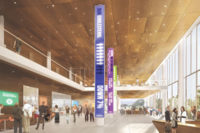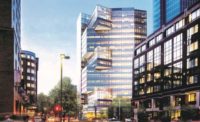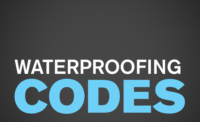
A $180 million mixed-use development tower located in the heart of downtown New Haven, Conn., 360 State Street is the state’s largest private residential building. Photographs by Michael R. Fisher, the fisher group, LLC.
At 32 stories and 670,000 square feet, 360 State Street is Connecticut’s largest private residential building. The $180 million mixed-use development tower is located in the heart of downtown New Haven, Conn. The building is the first residential project to receive LEED (Leadership in Energy and Environmental Design) Platinum certification. It contains 500 apartment units and features street-level retail space, a grocery store, an early childhood learning center, and multi-story below-ground parking garage.
The waterproofing phase of the project was crucial and the schedule was tight, so everyone involved in the project wanted to ensure it was completed per the manufacturer’s specifications. The manufacturer, Colloid Environmental Technologies Company (CETCO), offers the HydroShield Quality Assurance Program. The program ensures that installation is done by approved applicators. It also provides design assistance, system review, and job-specific construction details, as well as independent inspection, financial assurance and technical support throughout the construction phase.

The underslab application at 360 State Street was particularly difficult due to the varying elevations of the structural mat slab. The foundation mat incorporated a 3-inch-thick, 2,500 psi non-reinforced concrete mud slab to achieve a suitable working platform.
A Connecticut-based building envelope consulting firm, the fisher group, LLC, was the certified third-party inspection firm appointed by the owner for the quality assurance program. The independent inspection services considered every phase and aspect of the application throughout the duration of the project to ensure the waterproofing and ancillary products - most notably the waterstops - were installed in strict compliance with the waterproofing manufacturers’ guidelines. This proved to be an effective quality control measure.
All pertinent field activities relevant to the waterproofing application were documented on a regular basis. Immediately following each site visit, a comprehensive written and photographic field report was compiled.
The Waterproofing System
The principal waterproofing product used for this application was Voltex DS, as manufactured by CETCO. Voltex DS is a unique composite comprised of two high-strength geotextiles, 1.10 pounds of granular sodium bentonite per square foot, and an integrated high-density polyethylene (HDPE) liner. The two geotextiles are interlocked by a proprietary needle-punching process which encapsulates the bentonite and keeps it uniformly distributed throughout the product. Voltex DS is available in rolls that are 4 feet wide and 14.5 feet long.Voltex DS can be installed directly to green concrete without primers or adhesives in virtually any weather condition, including below freezing and damp conditions and is a highly effective and proven waterproofing system for both new and remedial waterproofing projects worldwide.

The Voltex and Voltex DS were installed with the dark gray geotextile facing toward the pour to achieve a strong mechanical bond to the concrete. Surface water and snow collected atop the mud slab was squeegeed off prior to the waterproofing application.
A Challenging Project
The waterproofing phase of the project encompassed the entire building foundation structure. The waterproofing phase featured a variety of applications including underslab, backfilled foundation walls, concrete masonry unit (CMU) foundation walls, elevator pit foundation and grade beams. It also included property line construction, a blind-side application incorporating “Z” section steel sheet piling and stabilized earth retention walls.The project presented a variety of challenges, most notably the necessity of performing the underslab waterproofing installation - most critical phase of the project - during the winter season and under continuous hydrostatic conditions.
Voltex DS was well suited for this application because of its durability and jobsite survivability. The product is capable of withstanding frequent freeze/thaw cycles and constant water contact, which consequently better facilitated the installation and minimized any construction delays. Furthermore, the ease of installation made for an efficient and productive application even during the harsh weather conditions.
Substrate Inspection
In compliance with the manufacturer’s quality assurance program requirements, a thorough inspection of the substrate, i.e. mud slab, shoring, concrete, compacted earth or gravel sub-grade, etc., was required to verify that the substrate to which the product is installed is acceptable to support the waterproofing construction and to identify any unsatisfactory conditions which may impair or otherwise compromise the performance of the waterproofing system.
The reinforcing bars were supported by concrete bricks to alleviate the possibility of membrane puncture and better distribute the excessive weight of the rebar. Supplemental attachment of the Voltex field sheet was provided at elevation transitions to prevent displacement of the sheet during the waterproofing installation.
• Mud slab: Mud slab shall exhibit a uniform surface profile and smooth planer surface without any surface imperfections/irregularities, e.g., voids, depressions, cracks, ridges or physical damage.
• Compacted soil or gravel: Substrate shall be satisfactorily compacted to a minimum 85 percent modified proctor density and uniformly graded, free of standing (ponding) water or ice, foreign debris, and large diameter aggregate/stones.
• Shoring/timber lagging: Shoring and timber lagging shall be free of excessive gaps or cavities, irregular surfaces, or surface projections (nails, tie-rods, anchors, etc.).
• Concrete: Concrete should be properly placed and consolidated, structurally sound condition exhibiting a satisfactorily smooth finish. Raised surface conditions such as form fins, ridges and the like should be ground smooth. Moderate to severe honeycombing, poorly consolidated concrete, voids, and form-tie holes should be filled with non-shrink cementitious grout.

A full-width sheet of Voltex DS was provided at the base of all blind-side wall (vertical) transition conditions. The blind-side waterproofing course consisted of a dual-layer application and the end laps of each sheet were offset.
Project Details
The underslab waterproofing was a dual-layer application. In this instance, Voltex DS comprised the principal waterproofing layer and Voltex was utilized as a protection course. The protection course was installed directly atop and perpendicular to the Voltex DS sheet, considering the amount of construction traffic and the loads which would be imposed during the construction, most notably the extensive reinforcing associated with the mat-slab foundation.In keeping with the manufacturer’s installation criteria, the Voltex DS underslab waterproofing end laps were staggered a minimum of 12 inches from the preceding membrane course. Both the Voltex DS and Voltex protection course laps (end and side laps) were mechanically fastened independent of one another at intervals (maximum 24 inches on-center spacing) using 5/8-inch-by-1¼-inch-wide heavy-duty staples to safeguard against displacement before and during the concrete placement. A lever-operated heavy-duty box stapler was used in this procedure.
The Voltex DS waterproofing at vertical surface conditions (foundation walls) was discontinued just below finished grade level. The grade termination condition basically consisted of a one-inch wide extruded aluminum termination bar mechanically fastened 12 inches on-center with a Hilti pin and plate washer. The bar and terminated membrane edge were completely encapsulated with Bentoseal. The grade termination is concealed to view buried within the backfill and landscaping.

In conjunction with the waterproofing installation, Waterstop-RX, a sodium bentonite waterstop manufactured by CETCO, was provided at all vertical and horizontal construction joints and through-wall/slab penetrations.
Conclusion
The total waterproofing installation (walls and underslab) represented approximately 35,000 square feet of surface area. Since the completion of the project and building occupancy, there has been no evidence of water ingress. The benefits of the HydroShield Quality Assurance Program, design assistance from CETCO, inspection services performed by the fisher group, LLC, and the durability of the products used made for a successful and timely installation and a dry building.Michael R. Fisher is the principal owner of the fisher group, LLC, a Connecticut-based building envelope consulting firm. He has over 27 years of experience in the design, evaluation and investigation of roofing and waterproofing systems, and all aspects of building restoration including exterior waterproofing, masonry and concrete rehabilitation.
Just the Facts
Project: 360 State StreetLocation: New Haven, Conn.
Material: CETCO Voltex DS
Third-Party Inspection Firm: the fisher group, LLC, Oxford, Conn.
Applicator: Kelly Enterprises, North Haven, Conn.
Construction Manager: Suffolk Construction Co., Inc.
Architect/Developer: Becker + Becker


